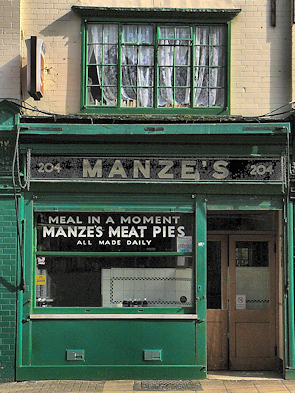|
|
 |
|
Lewisham/Greenwich
|
 |
A historic Thames-side settlement, situated west of
Greenwich. Its name is a corruption of ‘deep ford’. In The Spirit of London’s River, LM Bates says of Deptford waterfront
“This was the ground from which, more than any other, grew the British Empire.” Henry VIII founded a naval dockyard
here in 1513 and within a century Deptford had become one of the country’s leading ports and a major industrial suburb.
Many of the greatest figures of sixteenth and seventeenth century English history had associations with Deptford. In 1577
Francis Drake sailed from Deptford via Plymouth for a three-year circumnavigation of the globe, claiming a portion of present-day
California for Elizabeth I . On his return, Drake was knighted by the Queen after she had dined aboard the Golden Hind at
Deptford. In 1593 the dramatist Christopher Marlowe was killed here, reputedly in a tavern brawl. Anthony Burgess’s
A Dead Man in Deptford is one of the works to suggest a conspiratorial aspect to the affair. The diarist John Evelyn came
to Deptford in 1652 to live at Sayes Court, a house belonging to his wife’s family, which he rented to Peter the Great
of Russia in 1698 during his visit to learn the art of shipbuilding. Evelyn discovered woodcarver and sculptor Grinling Gibbons
toiling in a lowly Deptford workshop and introduced him to Christopher Wren. Gibbons went on to become a master carver under
five British sovereigns. Another illustrious diarist, Samuel Pepys, worked in Deptford as an admiralty official. From the
closure of the dockyard in 1869 and of the cattle market that replaced it in 1913, through Second World War bombing and postwar
industrial decline, Deptford has suffered a long and damaging period of deterioration but it is now the focus of extensive
regenerative building, both commercial and residential, from Deptford Bridge in the south to the Pepys estate by the river.
Deptford Creek is a planned site for further major riverside developments.
Deptford High Street still has terraced buildings from the late seventeenth century and the
eighteenth century and, although they are sometimes hard to spot amongst all the newer intrusions, they represent an undervalued
part of London’s architectural heritage. According to a 2005 press story, a novel mathematical formula has determined
that the High Street is London’s best place to shop, because of the variety of its stores.
 |
 |
|
|
|
 |

|
| A traditional London pie and mash shop on Deptford High Street |
Deptford has a large black community, mostly of African
origin. With few pensioners and many children, the average resident of Evelyn ward is aged only 30.7 – compared with
38.6 for the whole of England and Wales. Under a fifth of homes are owner-occupied and 15 per cent are lone parent households.
Deptford has London’s largest Buddhist community, comprising 4.4 per cent of the total population.
The National
Maritime Museum has LS Lowry’s nondescript Deptford Power Station: from Greenwich (1959). The rock band Dire
Straits was founded in Deptford in 1977.
|
 |
|
|
|
|
|
Postal district: SE8
Population: 14,512 (Lewisham’s Evelyn ward)
Stations: South Eastern (Deptford, zone 2)
and Docklands Light Railway, Lewisham branch (Deptford Bridge, zones 2 and 3)
Further reading: Jess Steele, Turning the Tide: The History of Everyday Deptford, Deptford Forum Publishing, 1993
and Neil Gordon-Orr, Deptford Fun City: A Ramble Through the History and Music of New Cross and Deptford, Past Tense, 2004

Text and selected images are reproduced with the permission
of Chambers but may differ from the published versions
All content © 2005–2010
|
|
|
 |

